INT102: Communication Strategies for Indigenous Australians
VerifiedAdded on 2023/06/14
|7
|1350
|244
Report
AI Summary
This report investigates effective communication skills essential for engaging with Aboriginal and Torres Strait Islander peoples, addressing the INT102 Interpersonal Communication Skills Assessment 3 requirements. It identifies barriers such as historical distrust, language differences, and nonverbal communication nuances. The report emphasizes the importance of building relationships, using clear language, and being mindful of cultural differences in nonverbal cues like eye contact and silence. It also highlights the significance of respecting community elders and seeking assistance from local Aboriginal and Torres Strait Islander staff. Furthermore, the report identifies resources and networking opportunities through government and non-government agencies to foster valuable alliances with Aboriginal groups. Desklib provides access to this and many other solved assignments.
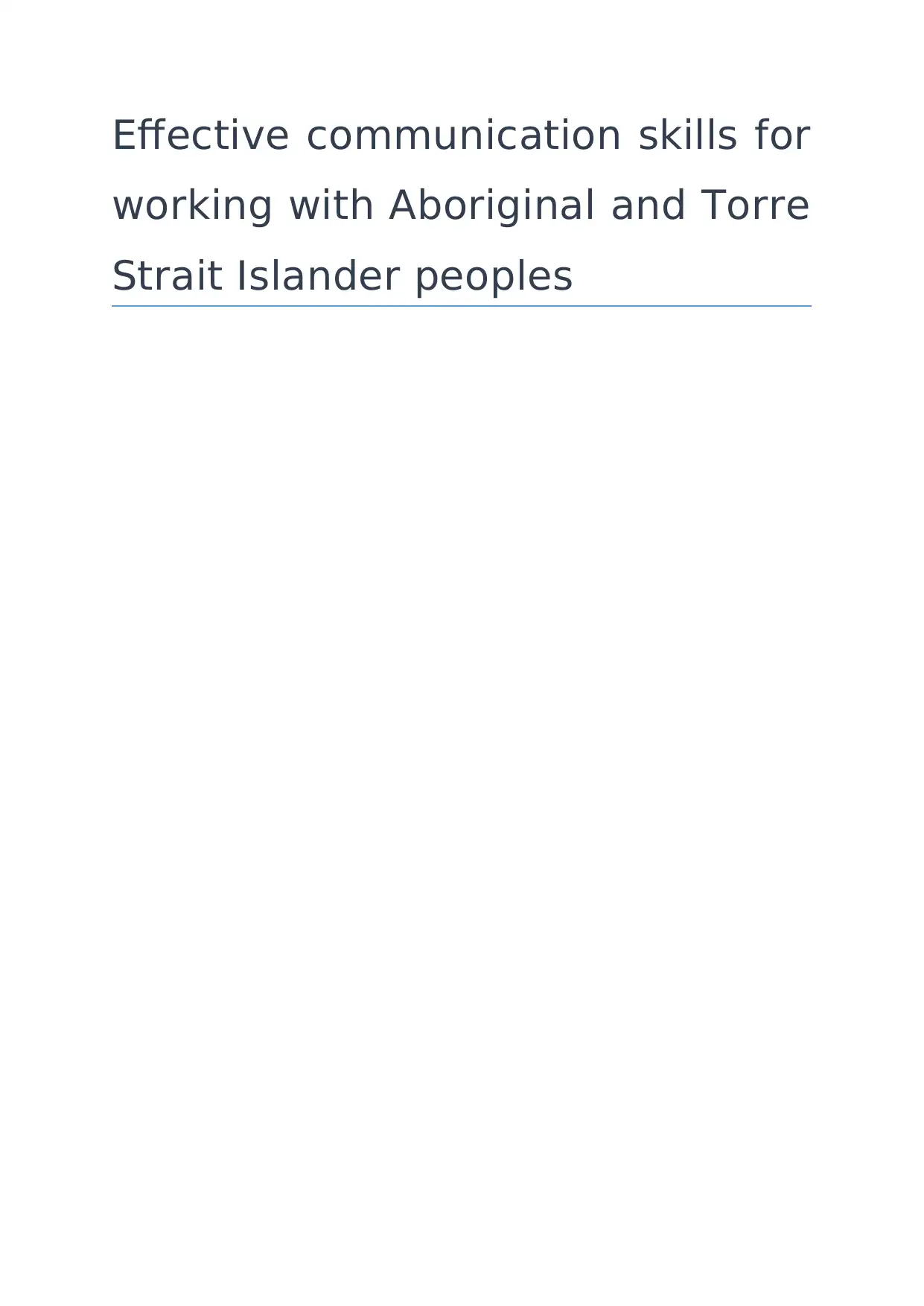
Effective communication skills for
working with Aboriginal and Torre
Strait Islander peoples
working with Aboriginal and Torre
Strait Islander peoples
Paraphrase This Document
Need a fresh take? Get an instant paraphrase of this document with our AI Paraphraser
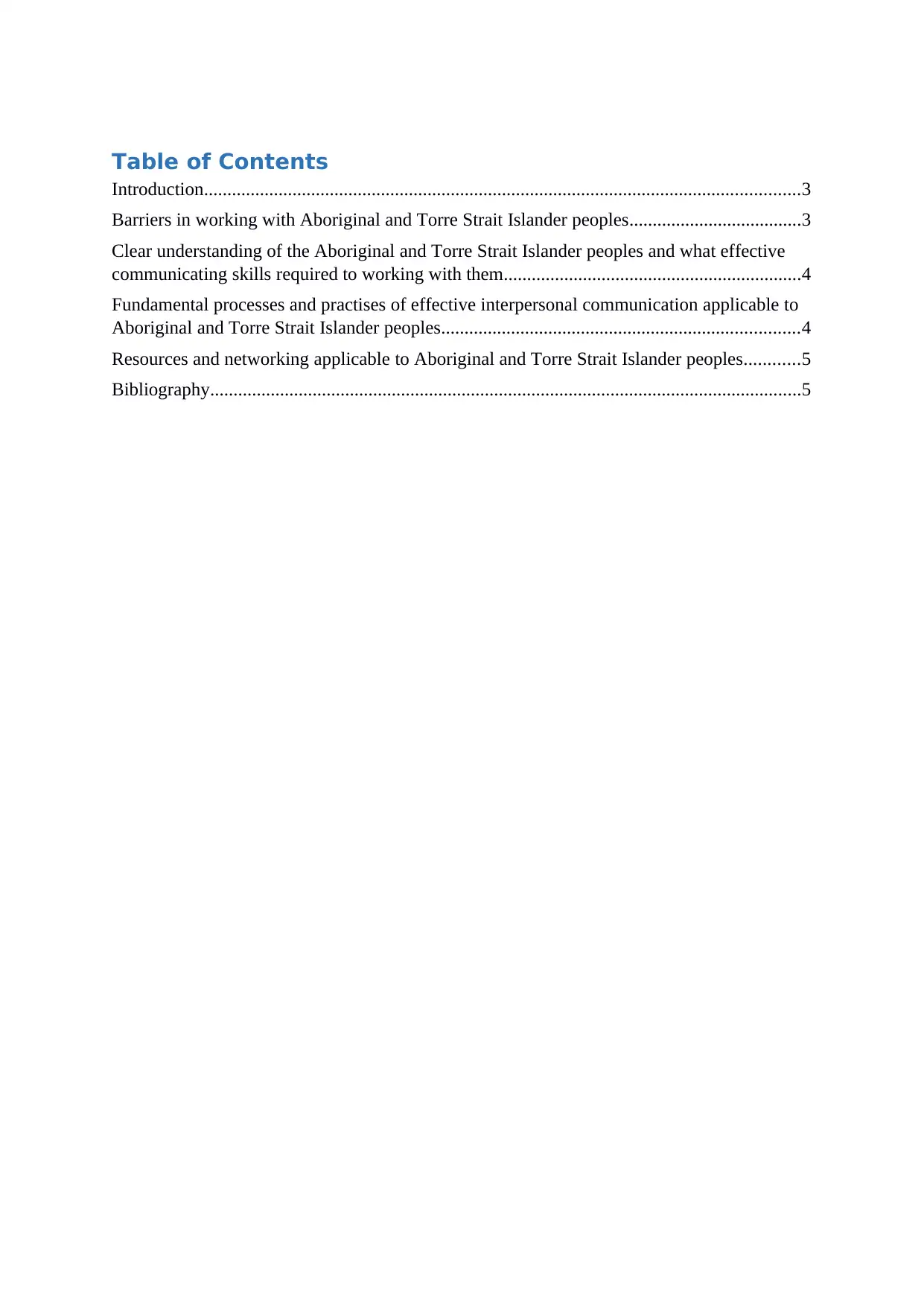
Table of Contents
Introduction................................................................................................................................3
Barriers in working with Aboriginal and Torre Strait Islander peoples.....................................3
Clear understanding of the Aboriginal and Torre Strait Islander peoples and what effective
communicating skills required to working with them................................................................4
Fundamental processes and practises of effective interpersonal communication applicable to
Aboriginal and Torre Strait Islander peoples.............................................................................4
Resources and networking applicable to Aboriginal and Torre Strait Islander peoples............5
Bibliography...............................................................................................................................5
Introduction................................................................................................................................3
Barriers in working with Aboriginal and Torre Strait Islander peoples.....................................3
Clear understanding of the Aboriginal and Torre Strait Islander peoples and what effective
communicating skills required to working with them................................................................4
Fundamental processes and practises of effective interpersonal communication applicable to
Aboriginal and Torre Strait Islander peoples.............................................................................4
Resources and networking applicable to Aboriginal and Torre Strait Islander peoples............5
Bibliography...............................................................................................................................5
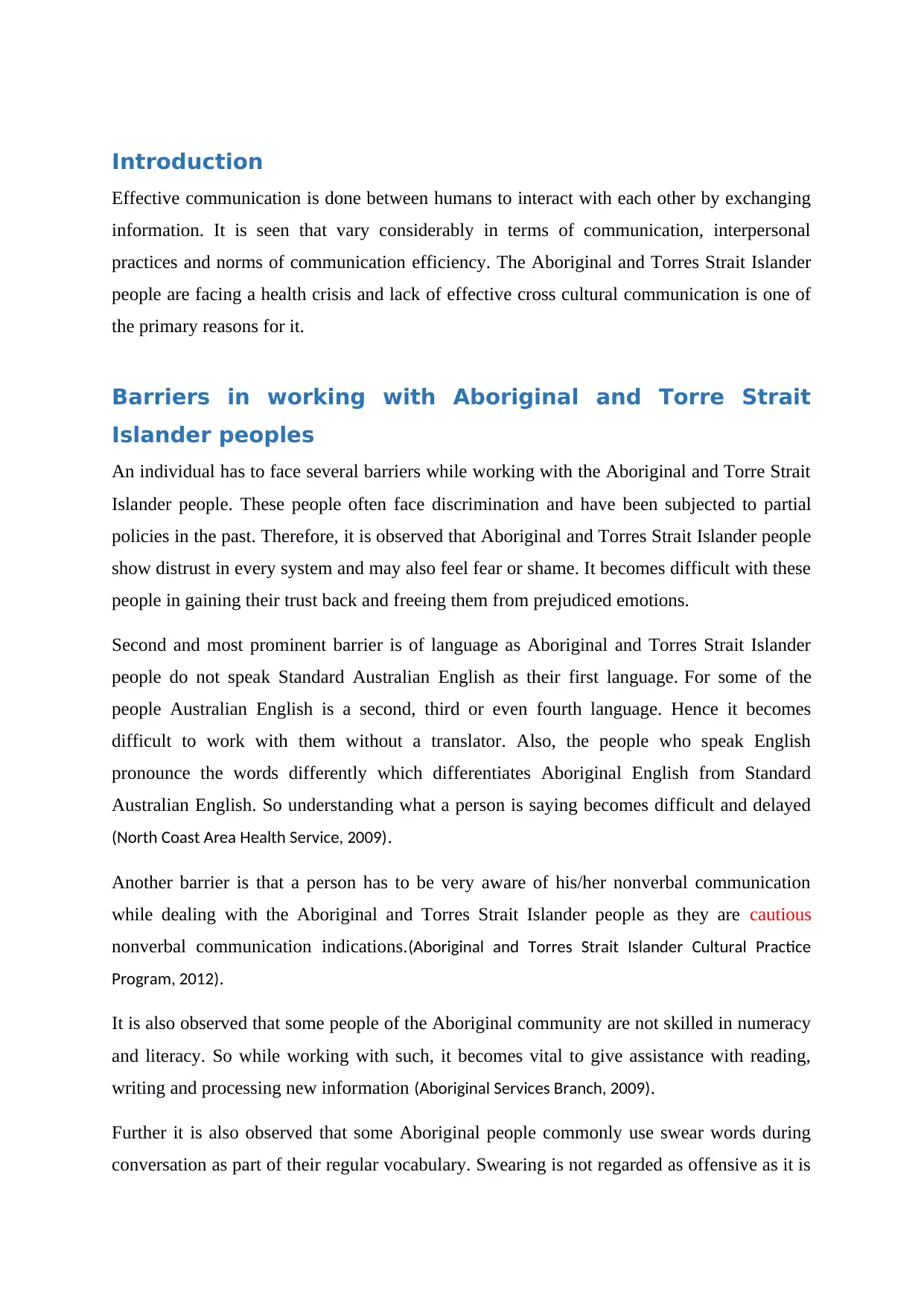
Introduction
Effective communication is done between humans to interact with each other by exchanging
information. It is seen that vary considerably in terms of communication, interpersonal
practices and norms of communication efficiency. The Aboriginal and Torres Strait Islander
people are facing a health crisis and lack of effective cross cultural communication is one of
the primary reasons for it.
Barriers in working with Aboriginal and Torre Strait
Islander peoples
An individual has to face several barriers while working with the Aboriginal and Torre Strait
Islander people. These people often face discrimination and have been subjected to partial
policies in the past. Therefore, it is observed that Aboriginal and Torres Strait Islander people
show distrust in every system and may also feel fear or shame. It becomes difficult with these
people in gaining their trust back and freeing them from prejudiced emotions.
Second and most prominent barrier is of language as Aboriginal and Torres Strait Islander
people do not speak Standard Australian English as their first language. For some of the
people Australian English is a second, third or even fourth language. Hence it becomes
difficult to work with them without a translator. Also, the people who speak English
pronounce the words differently which differentiates Aboriginal English from Standard
Australian English. So understanding what a person is saying becomes difficult and delayed
(North Coast Area Health Service, 2009).
Another barrier is that a person has to be very aware of his/her nonverbal communication
while dealing with the Aboriginal and Torres Strait Islander people as they are cautious
nonverbal communication indications.(Aboriginal and Torres Strait Islander Cultural Practice
Program, 2012).
It is also observed that some people of the Aboriginal community are not skilled in numeracy
and literacy. So while working with such, it becomes vital to give assistance with reading,
writing and processing new information (Aboriginal Services Branch, 2009).
Further it is also observed that some Aboriginal people commonly use swear words during
conversation as part of their regular vocabulary. Swearing is not regarded as offensive as it is
Effective communication is done between humans to interact with each other by exchanging
information. It is seen that vary considerably in terms of communication, interpersonal
practices and norms of communication efficiency. The Aboriginal and Torres Strait Islander
people are facing a health crisis and lack of effective cross cultural communication is one of
the primary reasons for it.
Barriers in working with Aboriginal and Torre Strait
Islander peoples
An individual has to face several barriers while working with the Aboriginal and Torre Strait
Islander people. These people often face discrimination and have been subjected to partial
policies in the past. Therefore, it is observed that Aboriginal and Torres Strait Islander people
show distrust in every system and may also feel fear or shame. It becomes difficult with these
people in gaining their trust back and freeing them from prejudiced emotions.
Second and most prominent barrier is of language as Aboriginal and Torres Strait Islander
people do not speak Standard Australian English as their first language. For some of the
people Australian English is a second, third or even fourth language. Hence it becomes
difficult to work with them without a translator. Also, the people who speak English
pronounce the words differently which differentiates Aboriginal English from Standard
Australian English. So understanding what a person is saying becomes difficult and delayed
(North Coast Area Health Service, 2009).
Another barrier is that a person has to be very aware of his/her nonverbal communication
while dealing with the Aboriginal and Torres Strait Islander people as they are cautious
nonverbal communication indications.(Aboriginal and Torres Strait Islander Cultural Practice
Program, 2012).
It is also observed that some people of the Aboriginal community are not skilled in numeracy
and literacy. So while working with such, it becomes vital to give assistance with reading,
writing and processing new information (Aboriginal Services Branch, 2009).
Further it is also observed that some Aboriginal people commonly use swear words during
conversation as part of their regular vocabulary. Swearing is not regarded as offensive as it is
⊘ This is a preview!⊘
Do you want full access?
Subscribe today to unlock all pages.

Trusted by 1+ million students worldwide
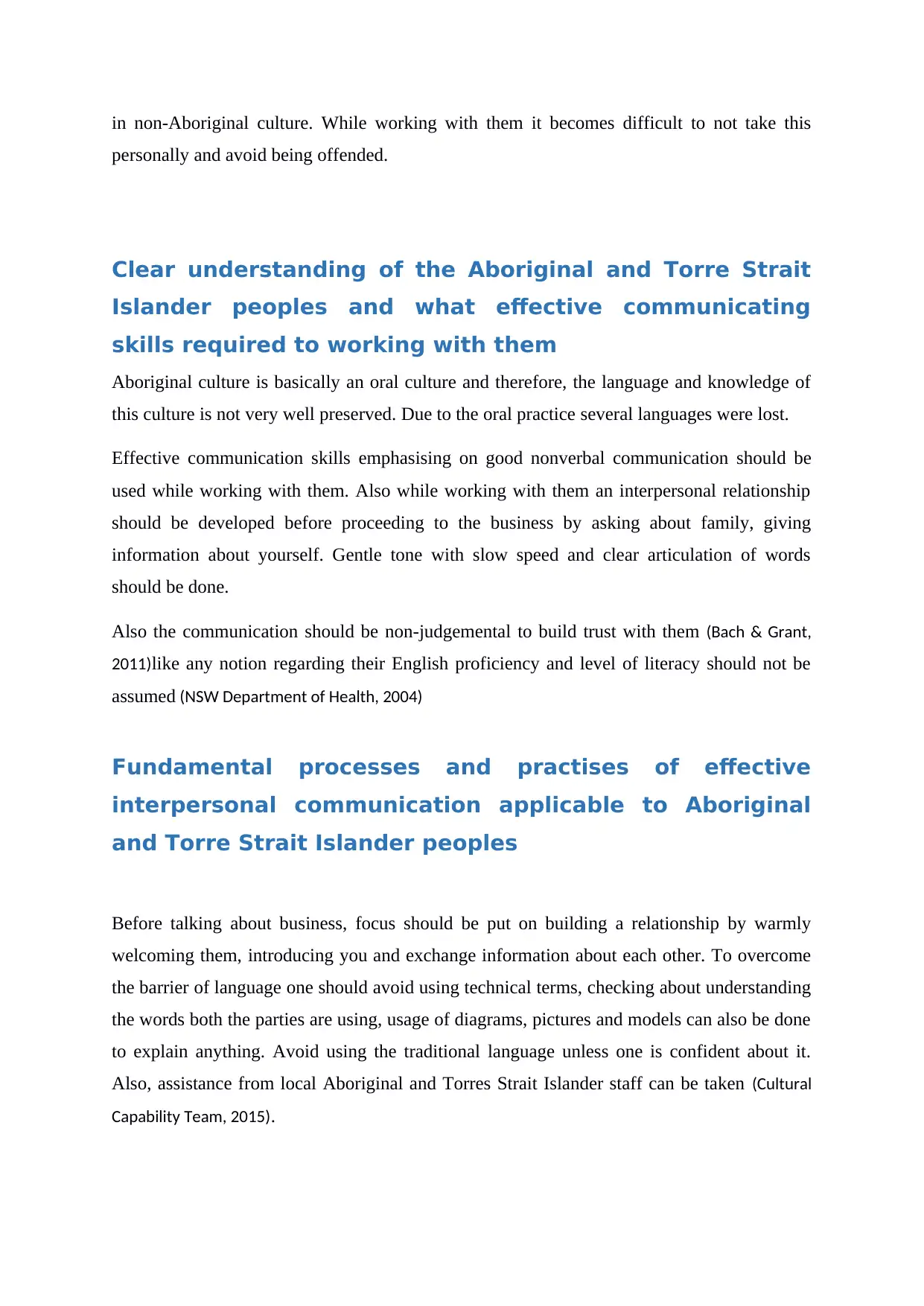
in non-Aboriginal culture. While working with them it becomes difficult to not take this
personally and avoid being offended.
Clear understanding of the Aboriginal and Torre Strait
Islander peoples and what effective communicating
skills required to working with them
Aboriginal culture is basically an oral culture and therefore, the language and knowledge of
this culture is not very well preserved. Due to the oral practice several languages were lost.
Effective communication skills emphasising on good nonverbal communication should be
used while working with them. Also while working with them an interpersonal relationship
should be developed before proceeding to the business by asking about family, giving
information about yourself. Gentle tone with slow speed and clear articulation of words
should be done.
Also the communication should be non-judgemental to build trust with them (Bach & Grant,
2011)like any notion regarding their English proficiency and level of literacy should not be
assumed (NSW Department of Health, 2004)
Fundamental processes and practises of effective
interpersonal communication applicable to Aboriginal
and Torre Strait Islander peoples
Before talking about business, focus should be put on building a relationship by warmly
welcoming them, introducing you and exchange information about each other. To overcome
the barrier of language one should avoid using technical terms, checking about understanding
the words both the parties are using, usage of diagrams, pictures and models can also be done
to explain anything. Avoid using the traditional language unless one is confident about it.
Also, assistance from local Aboriginal and Torres Strait Islander staff can be taken (Cultural
Capability Team, 2015).
personally and avoid being offended.
Clear understanding of the Aboriginal and Torre Strait
Islander peoples and what effective communicating
skills required to working with them
Aboriginal culture is basically an oral culture and therefore, the language and knowledge of
this culture is not very well preserved. Due to the oral practice several languages were lost.
Effective communication skills emphasising on good nonverbal communication should be
used while working with them. Also while working with them an interpersonal relationship
should be developed before proceeding to the business by asking about family, giving
information about yourself. Gentle tone with slow speed and clear articulation of words
should be done.
Also the communication should be non-judgemental to build trust with them (Bach & Grant,
2011)like any notion regarding their English proficiency and level of literacy should not be
assumed (NSW Department of Health, 2004)
Fundamental processes and practises of effective
interpersonal communication applicable to Aboriginal
and Torre Strait Islander peoples
Before talking about business, focus should be put on building a relationship by warmly
welcoming them, introducing you and exchange information about each other. To overcome
the barrier of language one should avoid using technical terms, checking about understanding
the words both the parties are using, usage of diagrams, pictures and models can also be done
to explain anything. Avoid using the traditional language unless one is confident about it.
Also, assistance from local Aboriginal and Torres Strait Islander staff can be taken (Cultural
Capability Team, 2015).
Paraphrase This Document
Need a fresh take? Get an instant paraphrase of this document with our AI Paraphraser
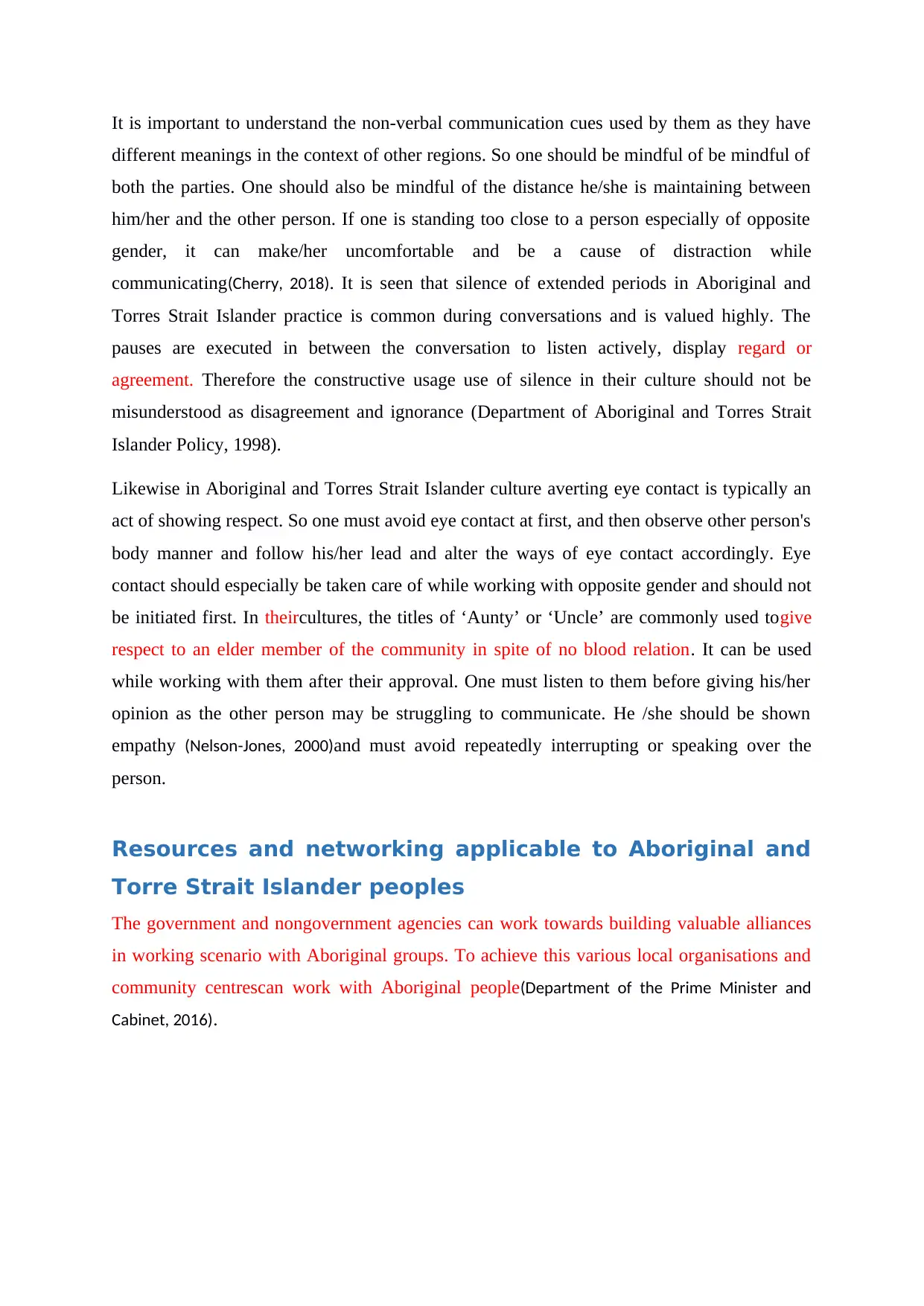
It is important to understand the non-verbal communication cues used by them as they have
different meanings in the context of other regions. So one should be mindful of be mindful of
both the parties. One should also be mindful of the distance he/she is maintaining between
him/her and the other person. If one is standing too close to a person especially of opposite
gender, it can make/her uncomfortable and be a cause of distraction while
communicating(Cherry, 2018). It is seen that silence of extended periods in Aboriginal and
Torres Strait Islander practice is common during conversations and is valued highly. The
pauses are executed in between the conversation to listen actively, display regard or
agreement. Therefore the constructive usage use of silence in their culture should not be
misunderstood as disagreement and ignorance (Department of Aboriginal and Torres Strait
Islander Policy, 1998).
Likewise in Aboriginal and Torres Strait Islander culture averting eye contact is typically an
act of showing respect. So one must avoid eye contact at first, and then observe other person's
body manner and follow his/her lead and alter the ways of eye contact accordingly. Eye
contact should especially be taken care of while working with opposite gender and should not
be initiated first. In theircultures, the titles of ‘Aunty’ or ‘Uncle’ are commonly used togive
respect to an elder member of the community in spite of no blood relation. It can be used
while working with them after their approval. One must listen to them before giving his/her
opinion as the other person may be struggling to communicate. He /she should be shown
empathy (Nelson-Jones, 2000)and must avoid repeatedly interrupting or speaking over the
person.
Resources and networking applicable to Aboriginal and
Torre Strait Islander peoples
The government and nongovernment agencies can work towards building valuable alliances
in working scenario with Aboriginal groups. To achieve this various local organisations and
community centrescan work with Aboriginal people(Department of the Prime Minister and
Cabinet, 2016).
different meanings in the context of other regions. So one should be mindful of be mindful of
both the parties. One should also be mindful of the distance he/she is maintaining between
him/her and the other person. If one is standing too close to a person especially of opposite
gender, it can make/her uncomfortable and be a cause of distraction while
communicating(Cherry, 2018). It is seen that silence of extended periods in Aboriginal and
Torres Strait Islander practice is common during conversations and is valued highly. The
pauses are executed in between the conversation to listen actively, display regard or
agreement. Therefore the constructive usage use of silence in their culture should not be
misunderstood as disagreement and ignorance (Department of Aboriginal and Torres Strait
Islander Policy, 1998).
Likewise in Aboriginal and Torres Strait Islander culture averting eye contact is typically an
act of showing respect. So one must avoid eye contact at first, and then observe other person's
body manner and follow his/her lead and alter the ways of eye contact accordingly. Eye
contact should especially be taken care of while working with opposite gender and should not
be initiated first. In theircultures, the titles of ‘Aunty’ or ‘Uncle’ are commonly used togive
respect to an elder member of the community in spite of no blood relation. It can be used
while working with them after their approval. One must listen to them before giving his/her
opinion as the other person may be struggling to communicate. He /she should be shown
empathy (Nelson-Jones, 2000)and must avoid repeatedly interrupting or speaking over the
person.
Resources and networking applicable to Aboriginal and
Torre Strait Islander peoples
The government and nongovernment agencies can work towards building valuable alliances
in working scenario with Aboriginal groups. To achieve this various local organisations and
community centrescan work with Aboriginal people(Department of the Prime Minister and
Cabinet, 2016).
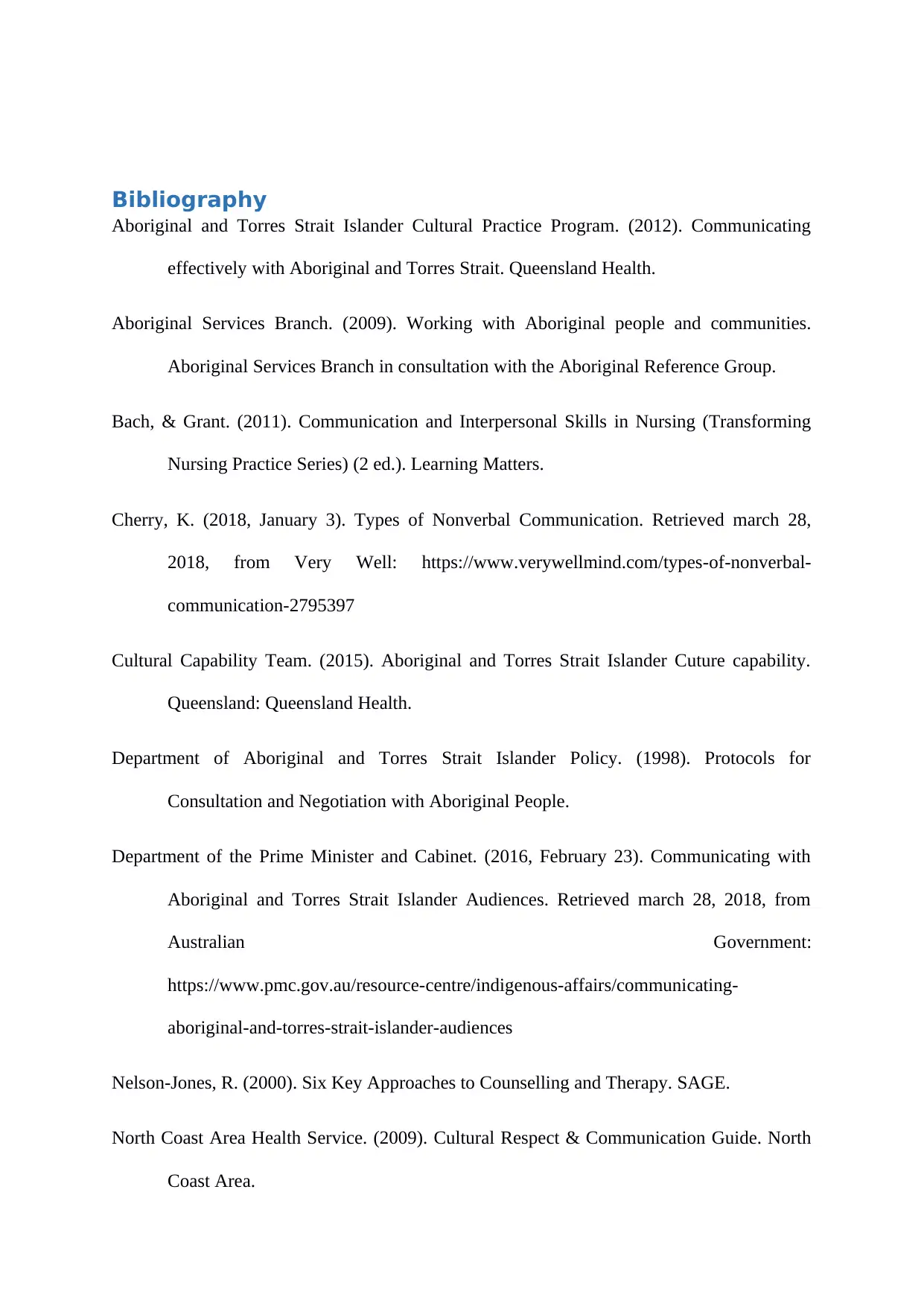
Bibliography
Aboriginal and Torres Strait Islander Cultural Practice Program. (2012). Communicating
effectively with Aboriginal and Torres Strait. Queensland Health.
Aboriginal Services Branch. (2009). Working with Aboriginal people and communities.
Aboriginal Services Branch in consultation with the Aboriginal Reference Group.
Bach, & Grant. (2011). Communication and Interpersonal Skills in Nursing (Transforming
Nursing Practice Series) (2 ed.). Learning Matters.
Cherry, K. (2018, January 3). Types of Nonverbal Communication. Retrieved march 28,
2018, from Very Well: https://www.verywellmind.com/types-of-nonverbal-
communication-2795397
Cultural Capability Team. (2015). Aboriginal and Torres Strait Islander Cuture capability.
Queensland: Queensland Health.
Department of Aboriginal and Torres Strait Islander Policy. (1998). Protocols for
Consultation and Negotiation with Aboriginal People.
Department of the Prime Minister and Cabinet. (2016, February 23). Communicating with
Aboriginal and Torres Strait Islander Audiences. Retrieved march 28, 2018, from
Australian Government:
https://www.pmc.gov.au/resource-centre/indigenous-affairs/communicating-
aboriginal-and-torres-strait-islander-audiences
Nelson-Jones, R. (2000). Six Key Approaches to Counselling and Therapy. SAGE.
North Coast Area Health Service. (2009). Cultural Respect & Communication Guide. North
Coast Area.
Aboriginal and Torres Strait Islander Cultural Practice Program. (2012). Communicating
effectively with Aboriginal and Torres Strait. Queensland Health.
Aboriginal Services Branch. (2009). Working with Aboriginal people and communities.
Aboriginal Services Branch in consultation with the Aboriginal Reference Group.
Bach, & Grant. (2011). Communication and Interpersonal Skills in Nursing (Transforming
Nursing Practice Series) (2 ed.). Learning Matters.
Cherry, K. (2018, January 3). Types of Nonverbal Communication. Retrieved march 28,
2018, from Very Well: https://www.verywellmind.com/types-of-nonverbal-
communication-2795397
Cultural Capability Team. (2015). Aboriginal and Torres Strait Islander Cuture capability.
Queensland: Queensland Health.
Department of Aboriginal and Torres Strait Islander Policy. (1998). Protocols for
Consultation and Negotiation with Aboriginal People.
Department of the Prime Minister and Cabinet. (2016, February 23). Communicating with
Aboriginal and Torres Strait Islander Audiences. Retrieved march 28, 2018, from
Australian Government:
https://www.pmc.gov.au/resource-centre/indigenous-affairs/communicating-
aboriginal-and-torres-strait-islander-audiences
Nelson-Jones, R. (2000). Six Key Approaches to Counselling and Therapy. SAGE.
North Coast Area Health Service. (2009). Cultural Respect & Communication Guide. North
Coast Area.
⊘ This is a preview!⊘
Do you want full access?
Subscribe today to unlock all pages.

Trusted by 1+ million students worldwide

NSW Department of Health. (2004). Communicating positively. North Sydney.
1 out of 7
Related Documents
Your All-in-One AI-Powered Toolkit for Academic Success.
+13062052269
info@desklib.com
Available 24*7 on WhatsApp / Email
![[object Object]](/_next/static/media/star-bottom.7253800d.svg)
Unlock your academic potential
Copyright © 2020–2025 A2Z Services. All Rights Reserved. Developed and managed by ZUCOL.




